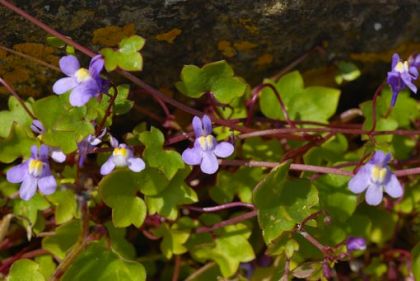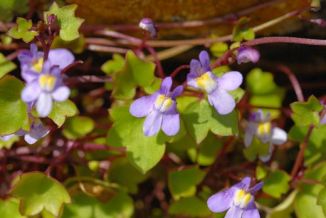This little flower is very commonly found growing on old walls and bare, waste ground. Its little lilac coloured flowers (8-15 mm across) have two lips, the upper is divided in two and the lower has three lobes with a pale yellow spot to guide in the nectar-seeking bees. Behind the lower lip is a small spur. The flowers are solitary on long, slender, sometimes reddish, stalks at the base of the leaves and bloom from May to September - although often its flowers can be seen in flower all year round. These leaves are ivy-shaped and, like the rest of the plant, hairless. The seed-planting mechanism of this plant is very clever indeed. The flowers turn their heads to the sun until they have been fertilised at which stage they turn about towards the wall on which they are growing and in this way they plant or push the seeds into any little crevice possible on the wall. They also have very long roots which help them to hang on, like the Ivy for which they are named, and thereby ensure their survival. This plant was introduced in the seventeenth century from the Mediterranean countries. It belongs to the family Plantaginaceae.
I first became aware of and identified this little plant growing in the grounds of my school in Donnybrook, Co Dublin sometime in the 1950's and I photographed it in 2006 at Baginbun Head, Co Wexford.
If you are satisfied you have correctly identified this plant, please submit your sighting to the National Biodiversity Data Centre



